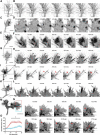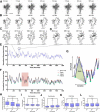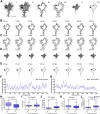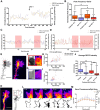Regulation of patterned dynamics of local exocytosis in growth cones by netrin-1
- PMID: 25834042
- PMCID: PMC6705414
- DOI: 10.1523/JNEUROSCI.0124-14.2015
Regulation of patterned dynamics of local exocytosis in growth cones by netrin-1
Abstract
Axonal guidance and synaptic specification depends on specific signaling mechanisms that occur in growth cones. While several signaling pathways implicated in cone navigation have been identified, membrane dynamics in growth cones remains largely unknown. We took advantage of SynaptopHluorin and high-speed optical recordings to monitor the patterns of membrane dynamics in rat hippocampal growth cones. We show that exocytosis occurs both at the peripheral and central domains, including filopodia, and that SynaptopHluorin signals occur as spontaneous patterned peaks. Such transients average approximately two per minute and last ∼30 s. We also demonstrate that the chemoattractant Netrin-1 elicits increases in the frequency and slopes of these transients, with peaks averaging up to six per minute in the peripheral domain. Netrin-1-dependent regulation of exocytotic events requires the activation of the Erk1/2 and SFK pathways. Furthermore, we show that domains with high SynaptopHluorin signals correlate with high local calcium concentrations and that local, spontaneous calcium increases are associated with higher SynaptopHluorin signals. These findings demonstrate highly stereotyped, spontaneous transients of local exocytosis in growth cones and that these transients are positively regulated by chemoattractant molecules such as Netrin-1.
Keywords: Netrin-1; SynaptopHluorin; exocytosis; growth cone.
Copyright © 2015 the authors 0270-6474/15/355156-15$15.00/0.
Figures







Similar articles
-
A signaling mechanism coupling netrin-1/deleted in colorectal cancer chemoattraction to SNARE-mediated exocytosis in axonal growth cones.J Neurosci. 2011 Oct 12;31(41):14463-80. doi: 10.1523/JNEUROSCI.3018-11.2011. J Neurosci. 2011. PMID: 21994363 Free PMC article.
-
Netrin-1 induces axon branching in developing cortical neurons by frequency-dependent calcium signaling pathways.J Neurosci. 2005 Jul 13;25(28):6702-15. doi: 10.1523/JNEUROSCI.0871-05.2005. J Neurosci. 2005. PMID: 16014732 Free PMC article.
-
Less than 5 Netrin-1 molecules initiate attraction but 200 Sema3A molecules are necessary for repulsion.Sci Rep. 2012;2:675. doi: 10.1038/srep00675. Epub 2012 Sep 20. Sci Rep. 2012. PMID: 22997549 Free PMC article.
-
[Netrin-1 and axonal guidance: signaling and asymmetrical translation].Med Sci (Paris). 2007 Mar;23(3):311-5. doi: 10.1051/medsci/2007233311. Med Sci (Paris). 2007. PMID: 17349294 Review. French.
-
Axon guidance: growth cones make an unexpected turn.Curr Biol. 2002 Mar 19;12(6):R218-20. doi: 10.1016/s0960-9822(02)00755-8. Curr Biol. 2002. PMID: 11909551 Review.
Cited by
-
FLIM FRET Visualization of Cdc42 Activation by Netrin-1 in Embryonic Spinal Commissural Neuron Growth Cones.PLoS One. 2016 Aug 2;11(8):e0159405. doi: 10.1371/journal.pone.0159405. eCollection 2016. PLoS One. 2016. PMID: 27482713 Free PMC article.
-
Non-proliferative neurogenesis in human periodontal ligament stem cells.Sci Rep. 2019 Dec 2;9(1):18038. doi: 10.1038/s41598-019-54745-3. Sci Rep. 2019. PMID: 31792338 Free PMC article.
-
Syntaxin-1 is necessary for UNC5A-C/Netrin-1-dependent macropinocytosis and chemorepulsion.Front Mol Neurosci. 2023 Sep 27;16:1253954. doi: 10.3389/fnmol.2023.1253954. eCollection 2023. Front Mol Neurosci. 2023. PMID: 37829513 Free PMC article.
-
A conserved role for Syntaxin-1 in pre- and post-commissural midline axonal guidance in fly, chick, and mouse.PLoS Genet. 2018 Jun 18;14(6):e1007432. doi: 10.1371/journal.pgen.1007432. eCollection 2018 Jun. PLoS Genet. 2018. PMID: 29912942 Free PMC article.
-
Netrin-1-Regulated Distribution of UNC5B and DCC in Live Cells Revealed by TICCS.Biophys J. 2016 Feb 2;110(3):623-634. doi: 10.1016/j.bpj.2015.12.022. Biophys J. 2016. PMID: 26840727 Free PMC article.
References
-
- Aguado F, Carmona MA, Pozas E, Aguilo A, Martínez-Guijarro FJ, Alcantara S, Borrell V, Yuste R, Ibañez CF, Soriano E. BDNF regulates spontaneous correlated activity at early developmental stages by increasing synaptogenesis and expression of the K+/Cl- co-transporter KCC2. Development. 2003;130:1267–1280. doi: 10.1242/dev.00351. - DOI - PubMed
-
- Bouchard JF, Moore SW, Tritsch NX, Roux PP, Shekarabi M, Barker PA, Kennedy TE. Protein kinase A activation promotes plasma membrane insertion of DCC from an intracellular pool: a novel mechanism regulating commissural axon extension. J Neurosci. 2004;24:3040–3050. doi: 10.1523/JNEUROSCI.4934-03.2004. - DOI - PMC - PubMed
Publication types
MeSH terms
Substances
LinkOut - more resources
Full Text Sources
Research Materials
Miscellaneous
